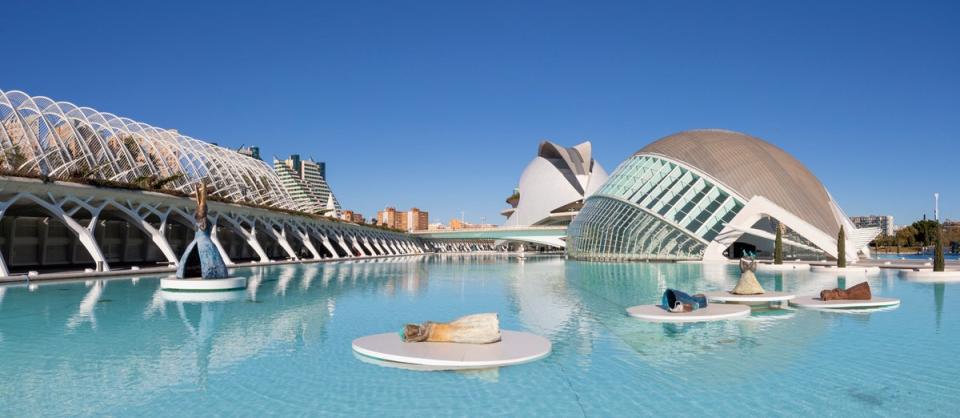The 5 best things to do in Valencia, from beach hopping to exploring by bike

If you're going on holiday to Valencia, a treat is in store. The charming, innovative and youthful city is often overshadowed by Spain's bigger metropolises – Madrid and Barcelona – but they fade into the background when you arrive in this Mediterranean municipality. It's long been considered to offer an incredibly high quality of living, with it’s warm climate, string of beaches and relatively affordable prices – all things that make it desirous as a city break destination.
It’s home to delightful contrasts too, between the character of its historic quarter and the extremely sci-fi City of Arts and Sciences, and from its urban heart to its green “river” running through the city like an artery. Wrap this together with on-trend bars and restaurants in which to linger, a culture-hit from museums and galleries, and an abundance of wide-open spaces, and you have yourself a special place in which to spend a few days or more.
Here are some of the best things to do when in Valencia.
Discover a city-within-a-city

Unmissable – quite literally. La Ciudad de las Artes y las Ciencias, or the City of Arts and Sciences, is a contemporary, otherworldly complex where arts, sciences and culture meet within structures designed by Santiago Calatrava, a Valencia-born architect. From the outside it’s all bright whites and deep blues across curvaceous shapes, set beside pools of baby-blue water.
Read more on Spain travel:
It’s impressive enough just to stroll a circuit of the ‘city-within-a-city’, ending with the (free to enter) L’Umbracle sculpture garden, but visitors can experience more with performances inside Palau de les Arts Reina Sofía, workshops within the interactive science museum, or immersive screenings at the planetarium, ‘laserium’ and IMAX cinema.
Dive below the sea without getting wet

One of the largest aquariums in Europe is also a highlight of the City of Arts and Sciences, and a perennially popular place to visit. In pure numbers, Oceanografic is impressive: 26,000 cubic metres of water to house its marine creatures, connected by more than 25 kilometres of pipes and behind almost 7,000 square metres of methacrylate panels (up to 33 centimetres thick).
But even more astonishing is the kaleidoscope of underwater life on show, from vibrant tropical fish to floating jellyfish. Each day there are dolphin shows and backstage tours and, as with everything in the City of Arts and Sciences, there’s plenty of avant-garde architecture to catch the eye.
Explore on foot (or bike)

Valencia is a wonderfully walkable city; in the centre you can set off from the Art Modern Institute Museum and, just 30 minutes, later after weaving through warrens of cobbled streets, find yourself looking up at Porta de la Mar, the reconstruction of one of Valencia’s old imposing gates. Discovering the Old City on foot allows you to take in the beautiful jumble of architecture – Romanesque to Baroque, Gothic to Neoclassical –as you amble, ticking off some of the main attractions: Plaza de la Reina, the old post office (pop inside to view the enormous glass dome) and the 15th-century Silk Exchange, built at the height of Valencia’s golden age.
Otherwise, swap legs for wheels and up your speed on a bike. The city is forgivingly flat and its layout easy to navigate (plus there are plenty of cycle lanes and wide streets). Two wheels are a brilliant way to roam Turia Garden, a 12km landscape stretch that follows the former path of the Turia river (which had its course altered to prevent flooding). It’s now a green calm space of woodland, palm trees and orange trees, that feels a world away from the city. Valenbisi bikes can be picked up and dropped off across Valencia at any time for solo exploration, and there are lots of group bike tours that can be booked.
Head down by the sea

That ultimate combination – city and seaside – is infused in Valencia’s soul. It simply feels like the Med should, so it’s little wonder that its shores are so tempting. Many beaches have darker sands, with El Saler among the exceptions. You’ll find the white sand less than 20 minutes from the city centre: a brilliantly untouched, untamed patch of coast that’s also a Blue Flag beach.
For something a little livelier, there’s Malvarrosa, adorned with rows of parasols and backed by paella restaurants; La Pepica is a popular choice, having opened its doors more than a century ago. Malvarrosa is also home to an artificial reef, so continue your aquatic education post- Oceanografic with some snorkelling.
Go au naturel at Albufera

Urban Valencia melts into dunes, pine forests and a lagoon when you head 10 miles south. More than 300 different species of birds call Albufera Natural Park’s body of water home, including waterfowl and flamingos. Rice paddies stretch for miles – this is where paella was invented – and there are six walking routes to traverse.
It’s easy to reach the park on local buses, which take less than an hour and cost €1.50 each way (or they’re free with a Valencia Tourist Card). Docks line the edge of the lagoon, and spending time on the water is a highlight, especially if it’s on a traditional handmade boat known as an albuferenc. Sitting on the water, the wooden boat gently rocking back and forth, is the finest way to experience sunset in Valencia.
Read more on the best hotels in Spain

 Yahoo News
Yahoo News 
